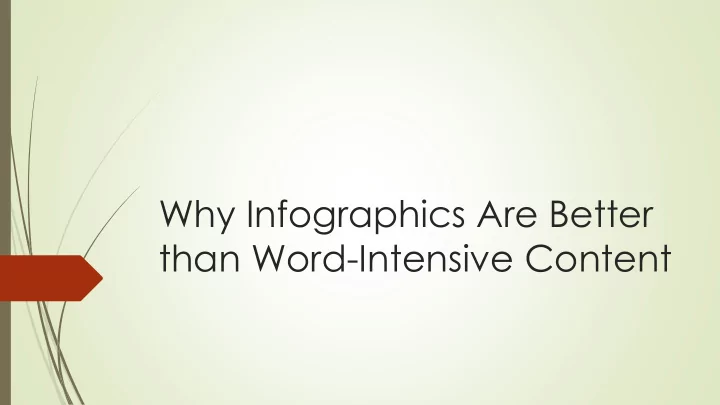

Why Infographics Are Better than Word-Intensive Content
Index 1. What are Infographics? 2. Types of infographics 3. The difference between infographics & Text Content 4. What does Google say about infographics 5. Benefits of using more targeted infographics 6. Success rate of Infographics Bounce rate Conversion rate Exit rate
1. What are Infographics? Infographics are visual representation of numeric and textual data. Essentially, they are used as visual guides, to convey a message in as little amount of words possible. With the amount of content we consume on a daily basis, infographics present the surest way digital content marketers can convey they ideas across and make sure that they stick. The human brain processes visuals better than text Ultimately the best way to tell a story in the shortest amount of time
Types of infographics The Statistical infographics (exhibit a) Informational infographics (exhibit b) Timeline infographics (exhibit c) Process infographics (exhibit d) Geographic infographics (exhibit e) Comparison infographics (exhibit f) Hierarchical infographics (exhibit g) List infographics (exhibit h) Resume infographics (exhibit i) How to Guides (exhibit j)
2. The Difference between Infographics & Text Content While both are informative modes of conveying a point across, their styles are different. Infographics are visual content pieces (this includes video infographics) More pictures and less words. Textual content relay a message in a much more descript and comprehensive format. More explanatory, word and number based content
4. What does Google say about Infographics Infographics have a separated ranking criteria of their own. Google uses Web Spiders to crawl an indexed page When it comes across a link, it then follows the link and indexes that page. While we are aware that Google looks at keywords, domain age, content, length, title tag, header tags and many other factors, infographics also play a huge role in a webpages ranking. Your site might not rank number one for a certain keyword, but your infographic may be first on the images search results.
5. Benefits of using more targeted infographics Effective ways of conveying a lot of complex information in a way that's easier to digest. Using charts and graphs that explain the numbers behind a story can be incredibly useful Screenshots with explanation and examples of what to do, how to use it, how to interpret that information, these types of infographics have huge value. Infographics are useful tool to build links on a page. Infographics are linkable content on the page. Great for social media platforms Another platform to fit keywords Infographics can expand beyond digital marketing
Success rate of Infographics Having spoken of the ability to capture the attention of the user much more quicker than a great caption, infographics have a much more higher success rate that written content. Here’s a list of markers that indicate the success rate of infographics on a webpage: Infographics retain the users attention span much longer than content which reduces bounce rate They improve the conversion rate of the searched keyword when the link building is done well. By extension, it improves the exit rate of the web page When optimized properly, infographics can be the used as a great vehicle to direct traffic from several platform to the website
Sources https://moz.com/blog/why-visual-assets-are-better-than-infographics- whiteboard-friday https://www.searchenginejournal.com/infographic-benefits/267781/ https://piktochart.com/blog/infographics-successful-seo-campaign/ https://thenextweb.com/insider/2015/07/29/why-infographics-are-the- secret-to-super-seo/ https://digitalmarketingphilippines.com/10-reasons-why-you-should-use- infographics-in-your-content-marketing-efforts/
Exhibit A
Exhibit b
Exhibit c
Exhibit d
Exhibit e
Exhibit f
Exhibit g
Exhibit h
Exhibit i
Exhibit j
Recommend
More recommend